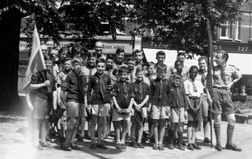A History of WHBC
 (Boys' Brigade 1937)
(Boys' Brigade 1937)
In 1934 the Revd Clifford Wood accepted the call to Winchmore Hill and in his first year a Men’s Contact Club was inaugurated and then in 1936 a church magazine was started, which continues to the present day. However another World War commenced only a few years later, which presented difficulties for everyone. Many were called up or evacuated and on two occasions the building was damaged by blast. The Minister (who had been a chaplain during the previous war) accepted a chaplaincy to troops stationed in the London district, but that did not prevent him from maintaining a normal pastoral oversight to the church. German prisoners of war came to the morning services for a while – following a special Christmas Service for them in 1946 – which were translated into German by one of the church members, speaking from the platform as the service progressed. In 1947 the present Communion table and central chair were presented to the Church by the Boy’s Brigade, in memory of the old boys of the Company who laid down their lives in the war. The Revd Clifford Wood retired in 1950, leaving behind him much gratitude and affection in the church and also in the surrounding area. Later he was commemorated by a room at the church being named after him.
 (Church Parade 1956 (Scouts))
(Church Parade 1956 (Scouts))
In 1946 the church was able to develop its long standing missionary interest in a practical way, when it sent out its first missionary, Sylvia Varley, who went to do medical work with the BMS in Congo. She was the first of many missionaries over the years. Some have gone for short time service and others for a life-time, serving with a variety of missionary organisations. The church has never, since then, been without several members serving abroad. At present six of our fellowship are working overseas, four in the Far East and two in South Africa. It should also be mentioned that over the years many people from the church have been engaged in various ministries in this country also.
From the 1950s on there were many new initiatives. In 1950 a Cub Pack started, followed three years later by a Scout Troop which was popular and well supported until 1974, when remaining members joined the Group at the URC church. Following the Billy Graham crusade at Haringey in 1955, the church held its own evangelistic campaign called ‘This is the Way’ which bore real fruit amongst members. Then in 1957, Jubilee celebrations were held which included a church presentation on the stage of Highfield School Hall. A Young People’s Fellowship (YPF) began in 1958 and continued very successfully until around 1972.
In 1962, as the Baptist Women’s League celebrated its fortieth anniversary, a Young Wives’ Club was started, which after a few name changes became the Ladies Contact Club in 1977. Evangelism has continued to be an important part of church life, with a mission in 1964, and another in 1967 marking the church’s Diamond Jubilee. These were followed over the years by various different evangelistic initiatives. 1967 also saw the rebuilding of a larger Carey Hall, using extra land that had been purchased behind the church.
From the 1950s on there were many new initiatives. In 1950 a Cub Pack started, followed three years later by a Scout Troop which was popular and well supported until 1974, when remaining members joined the Group at the URC church. Following the Billy Graham crusade at Haringey in 1955, the church held its own evangelistic campaign called ‘This is the Way’ which bore real fruit amongst members. Then in 1957, Jubilee celebrations were held which included a church presentation on the stage of Highfield School Hall. A Young People’s Fellowship (YPF) began in 1958 and continued very successfully until around 1972.
In 1962, as the Baptist Women’s League celebrated its fortieth anniversary, a Young Wives’ Club was started, which after a few name changes became the Ladies Contact Club in 1977. Evangelism has continued to be an important part of church life, with a mission in 1964, and another in 1967 marking the church’s Diamond Jubilee. These were followed over the years by various different evangelistic initiatives. 1967 also saw the rebuilding of a larger Carey Hall, using extra land that had been purchased behind the church.
